How is Wearable Tech new?
With the introduction of smart jewelry, fitness trackers, and healthcare body-mounted sensors, the phrase “wearable tech” emerged. It’s something of a buzzword, and though it describes these devices well, wearable tech can also mean adaptive and functional clothing and accessories. These concepts have been with us for ages. However, an explosion of technological advancements over the last century have enabled new creations that past generations couldn’t have even dreamed of. Around this innovation, an unprecedented industry has begun to form. Where is the workforce for it?
What is Wearable Tech?
We think of wearable technology as electronic, but you don’t have to be an engineer to create wearable tech. Wearable tech is any kind of functional clothing that uses innovation to help solve problems. It can be unique fabrics that protect our police and firefighters, running shoes that provide extra support for the arches of your feet, an orthopedic brace to help your bones and joints heal, or magnetic fasteners on clothing for people with arthritis.
Wearable technology is a broad term to mean ANY innovative wearable; the conversation is open to several disciplines. It is a conversation where everyone: every type of designer, health care worker, patient, and engineers come together to innovate.
How did I become part of it?
I was trained as a traditional fashion designer – I went to school for apparel design and worked in the industry, but I quickly realized I needed something more. I wanted to create clothing that improved lives. So, I decided to go back to school and get a graduate degree.
That is where I had the good fortune to see a presentation by Dr. Cole Galloway, the founder of GoBabyGo. GoBabyGo is an international association focused on community workshops teaching families how to build assistive technology for children with disabilities. Essentially, Cole teaches others how to build wheelchairs for children using powered ride-on cars for kids.
Kids using these adaptive devices attract other kids to play with them, versus the stigma that a large bulky power wheelchair may have. I was inspired by the results of Cole’s work and soon began volunteering with Cole’s lab.
I earned my bachelor’s and master’s degrees in Fashion Design from the University of Delaware and received my PhD in Biomechanics and Movement Science from the University of Delaware. My doctoral work includes The 5F Framework. I am trained in apparel design, kinesiology, human factors and motor development, and coding for wearable electronics and biomechanical analysis.
My career is also inspired by my work as a caregiver to my late husband. John had a chronic illness that affected his daily routine, independence, and overall quality of life. That experience informed my understanding of patient needs and my core values as a researcher: every project must begin with empathy and understanding of patient and caregiver needs.
These experiences helped direct me down a path where it made sense to combine my fashion design skills with my healthcare experiences. While people still seem perplexed by merging these two disciplines, I am researching this area, and it is a natural fit for me!

Where is it going?
Advancements like cheap solid-state storage, broadband internet, Bluetooth, microelectronics, and all kinds of new super fabrics have allowed wearable tech to blossom, not just into FitBits and Apple Watches, but into innovations that can dramatically increase quality of life. Now, wearable tech can expand its focus and accelerate.
Research, innovation, and retail worlds are chipping around the edges of adaptive, assistive, and protective apparel; however, it seems an untouched place by current fashion and medical industry leaders.
My goal is to set the standard—effectively creating a new industry. One that observes design, user-centered approach with state-of-the-art technology, new concepts, and smart fabrics and materials.
This new industry requires a qualified workforce to scale and reach the many who can benefit from the design approach. We need to bring it to the mainstream, and to that end, I am working on training a new workforce with students and other co-inventors involved in the core design process.
Over 75 students per year learn the 5F Framework and engage hands-on with every exploration and new design element. These students will bring empathy-based research to the mainstream, along with innovative wearable technology that will create more inclusion and diversity in our communities and places of business.
The first project was inspired and led by one of my students: Gabriella Zarlenga; she studied Medical Diagnostics at the University of Delaware and hoped to someday be a NICU nurse. The NICU or Neonatal Intensive Care Unit in the hospital wing caring for pre-term and/or medically fragile newborns.
In her courses, she learned the value of “kangaroo care” for newborns. Kangaroo care, or skin-to-skin contact in which the physical contact between a caregiver and baby for a given amount each day helps regulate the baby’s breathing, heart rate, and body temperature.
Gabriella had spent time shadowing nurses in the NICU and noticed that some of the NICU babies, due to their fragile condition, cannot receive kangaroo care. Gabriella came to the Innovation Lab as an inspired volunteer wanting to create a device that simulated skin-to-skin contact for babies not eligible for traditional kangaroo care. She asked me if she could do her own project based on this health problem. I was thrilled to support Gabriella and what became her team of student colleagues.
Now students in my lab are leading several types of projects! Creating products like exoskeletons for Achilles heel injuries, devices to support children’s heads, and prosthetics for kids. It is rewarding to grow a diverse and interdisciplinary team!
Where is it How do you Create a Workforce?
There’s a lot of overlap approaching health-related or healthcare-based problems from an interdisciplinary perspective. It is not generally taught to students. They tend to have a single track; they major in one discipline and work with other students in the same academic programs. It’s a single approach to a specific field. But the marketplace really isn’t made up like that. People don’t have narrowly defining jobs. So many of us are a Jack of all trades at work to solve problems and innovate.
In my partnerships with companies and corporations and feedback from industry talks, many of my collaborators or audience members say there is a demand for interdisciplinary skillsets. There are no applicants who fulfill that need because education is too narrow.
Approaching health-related devices from empathy and really understanding patients, challenges, and pathologies chronic disease is difficult. It is easy to fix a problem as if it’s like a broken toy or a clock that needs to be repaired. It is not only that health-related issue, but it affects their quality of life and their ability to do tasks. There’s so much a single approach can’t solve. Companies are interested in hiring staff with diverse backgrounds and in-depth understandings of patients.
Fashion companies see that students aren’t trained in adaptive clothing. They are trained in looking at New York runways to be inspired to work in ready to wear fashion or go to Paris and do haute couture. They about the more complex, practical problems with just as much excitement and interest around a fashion solution that a cocktail dress would generate.
Companies are looking for employees who can do something a little bit more innovative and more unusual. There’s plenty of opportunities that are just the status quo but helping to train a new workforce to succeed and excel in these different jobs is my goal.
There aren’t just fashion, merchandising, and design students in my lab. There are also engineers, nursing students, occupational therapists, to name a few. These students will have a broad and deep understanding of how to solve healthcare-related problems. Their education is entirely different from a standard mechanical engineering program, a traditional fashion design program, or a regular physical therapy program. They can think outside the box, pivot quickly, and have empathy to understand the problem. They won’t just push a widget onto the market, trying to design technology for the sake of technology. They’re really going to have a skill set that’s not currently represented.
The marketplace is exceptionally diverse. A single faceted major and a real homogenous kind of higher education experience won’t prepare an innovative workforce. Students need to be diversified in what they bring to the table. There are jobs that nobody currently is qualified for. The students I’m training will easily fill that niche because their education will give them a competitive advantage.
How do you become part of it?
Whether you are a student looking for a mentor, a healthcare worker, a patient struggling to find a solution to a particular challenge, or you work in fashion and want to collaborate, there are numerous ways to connect with me. Sign up for my email list and follow Fashionable science on Instagram, LinkedIn, Facebook, or Twitter! You may also reach out through email at [email protected]. I can’t wait to connect with you!

